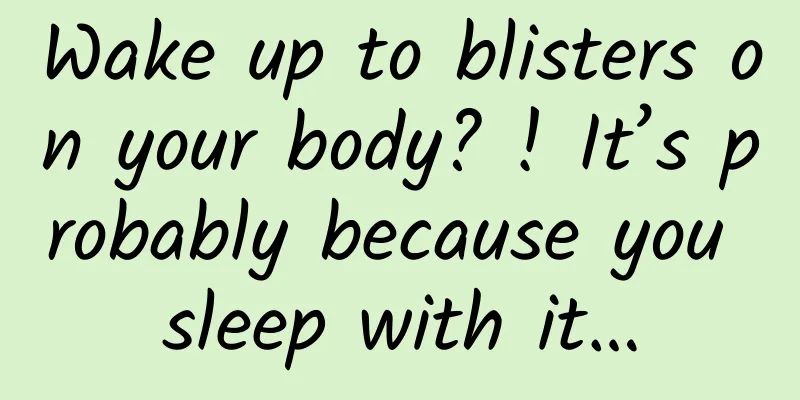Wake up to blisters on your body? ! It’s probably because you sleep with it…

|
As the weather gets colder, many people put a "heating artifact" in their beds - a hot water bottle, electric heater, etc. However, some people woke up the next day and found that the place where their skin came into contact with the "heating artifact" was burned by low temperature, and large blisters appeared... · When I woke up in the morning, there was an oversized bubble on my leg. It didn’t heal for several months. The scar fell off, but the flesh inside didn’t grow well. There was a big pit, and then a scar formed again… Many years ago, I had a low-temperature burn and got a very large blister. There is still a very obvious mark. You really have to be careful... It’s too dangerous. My brother was also burned by low temperature this year, but he didn’t feel it because he fell asleep… Many netizens have shared their personal experiences of being burned by low-temperature burns on online platforms, and reminded everyone to be careful when using "heating devices." Network screenshots According to statistics, burns caused by improper use of heating equipment are very common, accounting for 43.69% of all low-temperature burns. Among them, the most common causes are various hot water bottles and electric blankets, which account for 77.78% of burns caused by heating equipment. In addition, there are a small number of other heating equipment that deserve attention, that is, electric heating treasures, accounting for 22.22%. Low-temperature burns not only cause blisters on the skin, but can also cause serious complications if not properly treated. So, why does low temperature also cause burns? How to deal with low-temperature burns? Today we will answer them one by one. What is low-temperature burn? When we hear the word "scald", we usually think of boiling water, hot oil and flames. But in fact, low-temperature objects or environments can also cause burns, and they are even more likely to be ignored or misdiagnosed. Low-temperature burns, as the name suggests, refer to damage to the skin caused by contact with objects or environments at lower temperatures. Different from traditional high-temperature burns, low-temperature burns are usually caused by contact with objects or environments with a temperature below 60°C. When the contact time is long or the contact area is large, it may cause damage to the skin tissue and produce symptoms similar to high-temperature burns. Low-temperature burns and their associated heat sources (from references) Low-temperature burns are characterized by their slow development and hidden symptoms, which may not cause immediate pain. Many people do not notice them in the early stages, and do not pay attention to them until the symptoms worsen. Therefore, many people are slowly burned after falling asleep, and only discover that there is something wrong with their skin after waking up. Unfortunately, by the time they discover it, it is already too late. What is the lowest temperature that can cause low-temperature burns? This involves the threshold of causing low-temperature burns. As mentioned above, the upper limit of the temperature that causes low-temperature burns is generally 60°C. To be honest, this temperature is not high. The hot pot and hot dishes we eat, and the Kung Fu tea that many people drink, can easily exceed this temperature. However, our esophagus will not be easily burned in daily life, mainly because the contact time is relatively short and the temperature can be quickly reduced. To cause low-temperature burns, contact time is key, and the severity is proportional to the contact time. Studies have shown that lower temperatures (several minutes or even longer), even relatively cold objects, can cause symptoms such as redness, swelling, and blisters on the skin. The most extreme temperature is 44°C. According to research, the threshold for adult skin to perceive pain is slightly higher than 43°C, and low-temperature burns occur when the basal layer of the epidermis reaches 44°C. From 44°C to 60°C, the rate of tissue damage increases logarithmically with the linear increase in temperature. Below we would like to share a table that discusses the time required for different temperatures to cause burns. The time required to cause burns at different temperatures (organized from reference materials) Among them, second-degree burns are reversible injuries, leaving no obvious scars on the skin, and third-degree burns are injuries to the entire layer of the skin, leaving scars. From this table, we can again conclude that the severity of burns is proportional to the contact time, and very low temperatures (such as 45°C) are also harmful as long as the contact time is long. It is also important to note that children are more susceptible to low-temperature burns because their skin is thinner and less tolerant to heat. Similar studies have shown that children have a lower temperature threshold than adults to cause the same degree of burns. Screenshot of the network platform If you have these signs, It indicates low temperature burns The first thing to know is that the mechanism of low-temperature burns involves the accumulation and continuous conduction of heat energy. Due to the long-term contact between the skin and the heat source, the heat energy gradually accumulates and conducts to the deeper tissues, resulting in gradual damage from the surface skin to the deep tissues. In the early stages of low-temperature burns, the wound may appear shallow, but if the heat source is not removed in time, the deep tissues will be injured under continuous heating, and the lesions such as blisters formed will continue to exist and worsen. Low-temperature burns are graded according to the depth of skin burns and can include: first-degree burns (involving only the epidermis), second-degree burns (involving the epidermis and dermis), and third-degree burns (destroying the entire dermis and subcutaneous tissue). To understand low-temperature burns, we need to know some of its characteristics: The wounds are usually small in size but deep, and many are even third-degree burns. Often occurs on the limbs, especially the lower legs, where the skin is exposed to heat. The initial symptoms are usually mild, just redness of the skin, and many people may not feel pain or discomfort for a short period of time. Blisters may appear on the local skin, or even the skin may be damaged or ulcerated, which may cause pain, tingling, numbness or burning sensation The following pictures show some typical manifestations of low-temperature burns: Different forms of low-temperature burns (organized from reference materials) To deal with low temperature burns, you can do this Although low-temperature burns may seem minor, they may lead to more serious complications if not treated promptly. Therefore, it is important to understand how to treat low-temperature burns. The following are common treatment steps: Immediately move away from low temperature sources: Once you find that your skin is in contact with a heat source for a long time, you should first move your skin away from the heat source quickly to avoid further damage. · Rinse with running water: Rinse the burned area with running water (no more than 40°C) to lower the temperature of the skin and relieve pain. There is no definitive answer to the specific rinsing time, but one indicator you can refer to is to rinse until the pain does not improve further, which may take several minutes. Protect wounds: Avoid using ice water or water that is too cold, as too low a temperature (e.g. below 10°C) may further aggravate the injury and risk frostbite and frostbite. If there is a wound, it is recommended to cover the wound with sterile gauze to reduce the risk of infection. Seek professional medical help: For more serious low-temperature burns (especially when there is ulceration, severe pain or numbness), or if you cannot judge whether it is a serious burn, it is recommended to seek medical help as soon as possible. Professional treatment is essential for recovery. The medical treatment of low-temperature burns varies from person to person, especially depending on the severity and extent of the burns. Specifically, treatment may include surgical excision, skin transplantation, local flap reconstruction and other methods. Different methods have their own scope of application, as well as their own advantages and disadvantages. Early, timely and appropriate treatment can reduce the treatment cycle of low-temperature burn patients, and they will recover better and more smoothly in the future. At this point, we want to emphasize that for low-temperature burns, prevention is more important than treatment. The key to prevention is that everyone should raise awareness of low-temperature burns, especially when using thermal treatment and heating equipment. When you have to use it, pay special attention to the details of use (such as product instructions). Summarize Seeing this, I believe everyone knows that low-temperature burns are a skin problem that can cause burns at temperatures as low as 44°C. It is not afraid of low temperatures. As long as the contact time is long, there is a risk of burns. Timely treatment and prevention of low-temperature burns are crucial to reduce damage and promote skin recovery. I hope this popular science article can help everyone better protect themselves and spend a safe winter. References [1]XieX,LiuX,CaiJ,etal.Characteristicsandaetiologyoflow-temperatureburnsinBeijingofChina.IntWoundJ.2023;20(6):2105-2112. [2]MartinNA,FalderS.Areviewoftheevidenceforthresholdofburninjury.Burns.2017;43(8):1624-1639. [3]LeeSH,SimSH,KiSH.Low-temperatureburnonreplantedfingersandfreeflapsinhand.AnnPlastSurg.2018;81(4):402-406. [4]ChoiMS,LeeHJ,LeeJH.Earlyinterventionforlow-temperatureburns:Comparisonbetweenearlyandlatehospitalvisitpatients.ArchPlastSurg.2015;42(2):173-178. [5] Zhou Z, Sun [6]Exposuretimetoreceiveasevereburn.https://antiscald.com/index.php?route=information/information&information_id=15 Planning and production Author: Tang Jiaoqing, attending physician of dermatology department Review | Feng Jun, Deputy Chief Physician, Dermatology Department, General Hospital of Datong Coal Mine Group Co., Ltd. |
<<: Don’t panic when monkeypox comes. Only by knowing “pox” can you fight “pox”!
>>: Exploring the secrets of sleep: from dreams to comprehensive nourishment of body and mind
Recommend
What to do if there are lumps in the milk
I believe that many new mothers have encountered ...
What are the contraindications of the Nano Spray Hydrating Device? How long does it take to charge the Nano Spray Hydrating Device?
The spray hydrator can provide moisture to the sk...
Who is responsible when two electric vehicles collide? How does electric vehicle insurance compensate?
Electric vehicles are a convenient and low-cost m...
Is it painful to have a blocked fallopian tube? Is it painful to have a blocked fallopian tube
There are many women of childbearing age who suff...
[Fat Bear Science] Can human serum albumin supplement nutrition and enhance immunity?
Miss Zhang next door has been very energetic thes...
Female rib valgus can be corrected
Rib valgus is what we call rib deformity. Some pe...
9 days after menstruation, there is light blood
Many women notice blood discharge after their men...
The January 2025 list was released, and these rumors were on the list →
Here is the list of "science" rumors in...
Why does my breasts itch when I wear underwear?
In order to ensure the shape and health of the br...
What is the cause of vulvar polyps?
People often say that there are some mucus secret...
Why does my breast hurt when I touch it? Ladies, please take a look
Women's chest pain must be taken seriously. I...
Can I take emergency contraceptive pills fifteen days after a medical abortion?
After medical abortion, it is best for women to r...
The fastest way to pass gas during cesarean section
The best way for pregnant women to give birth is ...
What is the cause of bleeding after intercourse with an IUD?
We are all familiar with many contraceptive metho...









